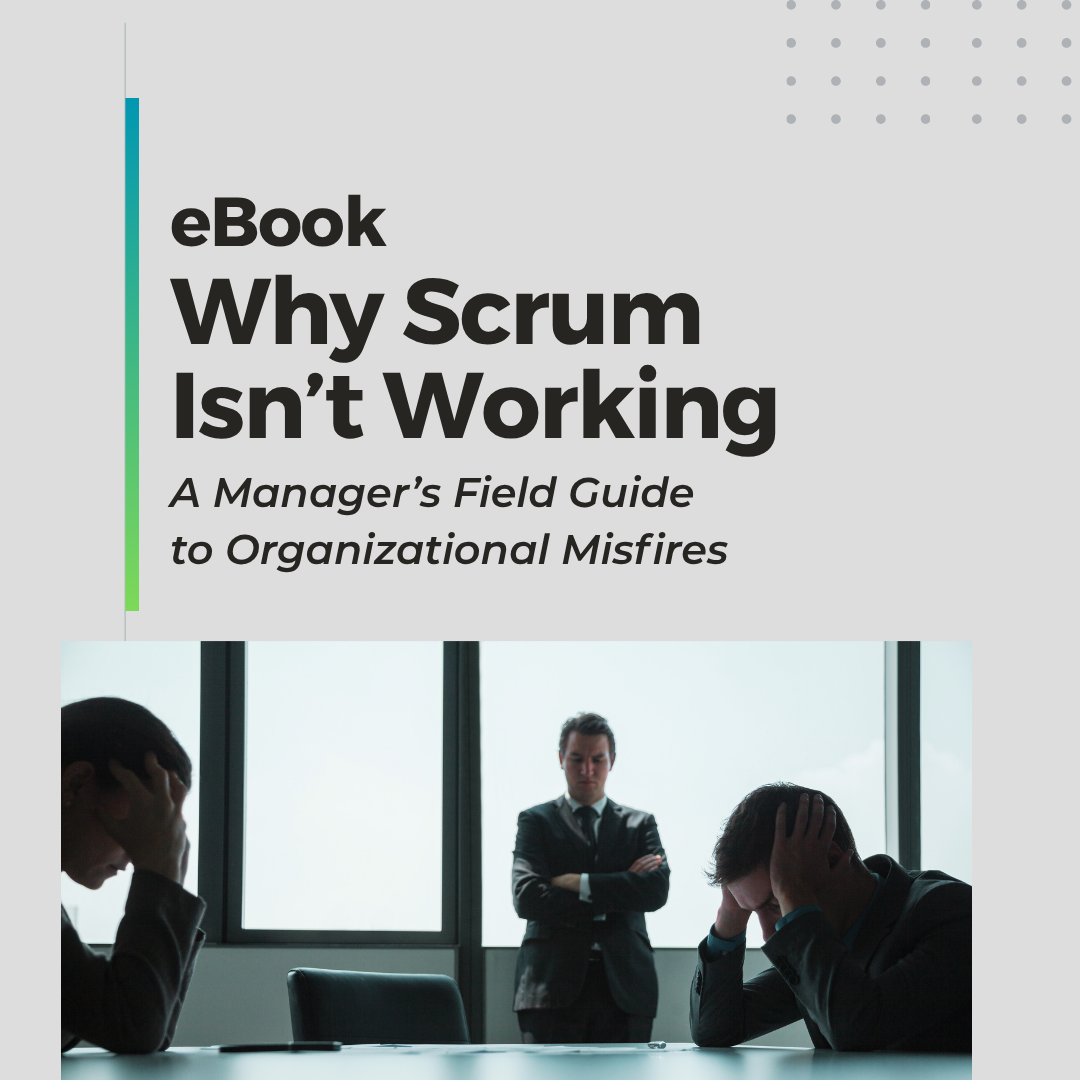
Scrum helps teams tackle complex problems, but even experienced practitioners make avoidable mistakes. These Scrum mistakes can limit progress, reduce collaboration, and block real value delivery. Here’s how to recognize them and fix what’s holding your team back
Scrum Mistakes and Why They Happen
Scrum was designed to help teams solve complex business problems through collaboration, transparency, inspection, and adaptation. Yet many teams that believe they are “doing Scrum” find themselves struggling to deliver consistent value. These struggles usually stem from subtle Scrum mistakes or misunderstandings about the framework’s intent rather than a lack of effort. Scrum is not just a checklist of meetings and paperwork; it is a framework built to create transparency, reduce risk, and help teams deliver meaningful outcomes. When teams misinterpret its purpose, they may continue to go through the motions of Scrum without seeing its real benefits.
The truth is that Scrum mistakes often emerge when teams focus on process over purpose. They try to optimize for speed, output, or predictability instead of focusing on customer impact and learning. When that happens, the framework starts to feel rigid instead of agile, and the very benefits Scrum promises—collaboration, flexibility, and faster feedback—fade away. Recognizing these patterns is the first step toward getting back on track.
Focusing on Story Points Instead of Value
One of the most common Scrum mistakes occurs when teams prioritize story points over delivering customer value. Story points were never intended to be a measure of productivity, yet many organizations treat them that way. Teams end up chasing higher velocity numbers, comparing themselves to other teams, or even tying bonuses to the number of points completed. This behavior undermines teamwork, encourages individuals to divide and conquer, and shifts focus away from solving real business problems. When velocity becomes the goal, quality and collaboration inevitably suffer.
To fix this:
Teams must return to the essence of Scrum: delivering value. Instead of celebrating a completed backlog item, celebrate a business outcome. Ask questions like, “Did this feature solve a real user problem?” or “Did our work make the product better?” By shifting the focus from output to outcome, teams can rebuild collaboration and ensure that their efforts create measurable impact. This mindset change restores Scrum’s original purpose of helping teams deliver meaningful results together.
Skipping or Ignoring Sprint Goals

Another major Scrum mistake is running Sprints without a clear, shared Sprint Goal. A Sprint Goal provides purpose and direction; it unifies the team around why they are doing the work, not just what they are doing. Without it, Sprints become mechanical, and the team loses sight of the product vision. The Scrum Guide emphasizes Sprint Goals for a reason: they create coherence, focus, and clarity about what success looks like for that Sprint.
To fix this:
Teams should make Sprint Goals a core part of their planning process. The Product Owner and Scrum Team should collaborate to define a meaningful goal before each Sprint begins. It does not have to cover every backlog item, but it should express a clear outcome that unites the work. When priorities shift, the Sprint Goal should guide decisions about what to change or remove. By keeping purpose at the center of planning, teams stay aligned and motivated even when the work gets difficult.
Not Delivering a Done Increment Each Sprint
Failing to produce a done increment every Sprint is one of the most damaging Scrum mistakes a team can make. An increment represents real, usable progress. It is something that could be released if the Product Owner chooses. When teams postpone integration, testing, or documentation, they increase risk and create uncertainty about the state of the product. These unfinished pieces pile up as technical debt, making it harder to adapt or release confidently later.
To fix this:
Teams should take their Definition of Done seriously and treat it as a shared commitment to quality. Every Sprint should result in something complete, tested, usable, and potentially releasable. This approach reduces risk and gives stakeholders a transparent view of progress. Producing a Done increment each Sprint builds trust with stakeholders, which helps organizations be comfortable with teams self-managing.
Leaving Stakeholders Out of Sprint Reviews
Sprint reviews are one of Scrum’s most valuable feedback loops, yet another common Scrum mistake is treating them as internal team meetings. Without stakeholders, the Sprint Review becomes an echo chamber. The Scrum Guide is clear that stakeholders are essential participants. They provide the perspective teams need to ensure they are building the right thing. When they are absent, teams risk drifting off course, delivering features that do not meet real needs, or missing opportunities to learn from customers early.
To fix this:
Teams should make stakeholder participation a regular and expected part of every Sprint Review. Invite people who represent different areas of the business, including executives, customers, and end users. Use the review to demonstrate progress, discuss challenges, and gather insights for future Sprints. When stakeholders are consistently involved, teams gain valuable feedback, strengthen alignment, and build trust across the organization.
Releases Don’t Need Sprint Boundaries

Many teams still believe that releases must wait until the end of the Sprint, but this is one of the most persistent Scrum mistakes. Scrum does not restrict release timing. The framework encourages continuous delivery of value whenever a done increment is available. If there is key stakeholder feedback required for a release you can get it earlier. Holding releases until the Sprint Review slows feedback, delays value delivery, and creates unnecessary bottlenecks. In a world that demands fast adaptation, waiting for arbitrary boundaries is counterproductive.
To fix this:
Teams should release as often as they are ready. As long as the increment meets the Definition of Done and any necessary approvals are in place, value can be delivered at any time. This flexibility accelerates learning, helps identify customer reactions sooner, and supports Scrum’s principle of adaptation. The Sprint Review should focus on feedback and collaboration, not as a release gate. Teams that embrace continuous delivery become more responsive, confident, and aligned with customer needs.
Are You Getting the Benefits Scrum Promised?
Following every Scrum rule does not guarantee success. The real goal of Scrum is to enable teams to create transparency, inspect, adapt, and deliver meaningful value in complex environments. When Scrum starts feeling rigid, that is a signal to re-examine how it is being applied. If your team is not collaborating effectively, lacks stakeholder feedback, or is not producing done increments regularly, you may be following the process but missing the purpose.
To fix this:
Teams should focus on value instead of velocity, define clear goals, ensure quality with every increment, involve stakeholders in key discussions, and release frequently to gather feedback. Scrum thrives on transparency, shared ownership, and a commitment to learning. When teams avoid these common Scrum mistakes, they rediscover the power of agility and the satisfaction of delivering products that truly matter.

If your Scrum team feels stuck, chances are small mistakes are adding up to big barriers. Misused events, unclear goals, and weak accountability can quietly erode progress and collaboration. Download our FREE eBook, Why Scrum Isn’t Working: A Manager’s Field Guide to Organizational Misfires, to uncover how these common missteps derail teams—and how to realign your Scrum practices to deliver the value your customers expect.


Continuous Learning is at the heart of great Scrum Teams
If you're ready to grow your understanding and improve how your team works, explore our upcoming Professional Scrum courses.
Want to see how Responsive Advisors can help you or your organization succeed? Learn more at responsiveadvisors.com.
